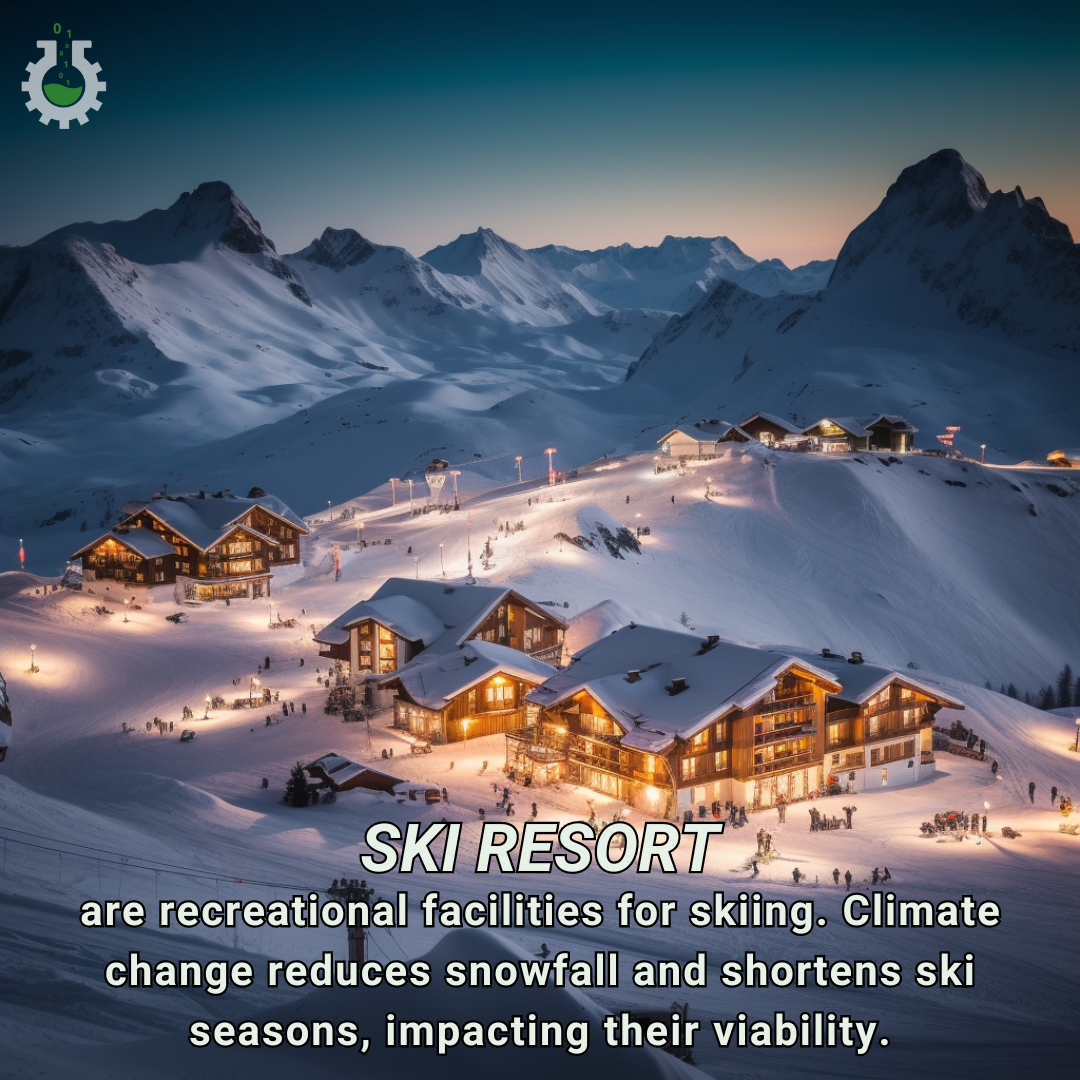July 1, 2024
Climate Change Poster Collection of the Day – Ski Resort
Book a Demo
Today’s Climate Change Poster Collection highlights Ski Resort, a recreational facility that provides amenities and services for skiing, snowboarding, and other winter sports. Typically located in mountainous regions with reliable snowfall, ski resorts offer a range of accommodations, ski lifts, trails, and equipment rentals to cater to winter sports enthusiasts. However, the viability and success of ski resorts are intrinsically tied to consistent and adequate snowfall, making them highly sensitive to climate change. As global temperatures continue to rise due to increased greenhouse gas emissions, the ski industry faces significant challenges that threaten its future.
Warmer winters and unpredictable weather patterns have led to reduced snowfall and shorter snow seasons, directly impacting the operational days of ski resorts. In some regions, the snowline—the elevation above which snow remains year-round—is rising, necessitating ski resorts to move higher up the mountains, often at great expense. This shift not only requires significant financial investment but also poses logistical challenges, as higher altitudes can be less accessible and may lack the necessary infrastructure to support large-scale tourism.
Additionally, the increased frequency of extreme weather events, such as heavy rain or unseasonably warm spells, can further disrupt ski resort operations. These weather anomalies can lead to sudden snowmelt, creating hazardous conditions for skiing and snowboarding. The unpredictability of weather patterns makes it difficult for ski resorts to plan their seasons, affecting everything from staffing to event scheduling. This uncertainty can result in financial losses and decreased visitor satisfaction, as tourists may find themselves facing poor conditions or closed trails.
To combat these challenges, many ski resorts have turned to artificial snowmaking, a costly and water-intensive process that is not a sustainable long-term solution. Snowmaking requires significant amounts of water and energy, often sourced from local water bodies, which can strain already limited resources. Furthermore, the production of artificial snow can have environmental repercussions, such as altering local ecosystems and affecting water quality. Despite these drawbacks, artificial snow has become a necessity for many resorts to ensure a consistent snow cover and extend their operating seasons.
The economic impact of climate change on ski resorts extends beyond the resorts themselves, affecting local economies that depend on winter tourism. Communities that rely on the influx of tourists for employment and business revenue are seeing diminished returns as fewer visitors frequent the resorts. This economic strain can lead to job losses, reduced investment in local infrastructure, and a decline in the overall quality of life for residents. Businesses that cater to tourists, such as restaurants, shops, and lodging facilities, also suffer from decreased patronage, creating a ripple effect throughout the local economy.
Moreover, the environmental impact of climate change on mountainous ecosystems cannot be overlooked. Melting glaciers and reduced snow cover can lead to soil erosion, loss of alpine habitats, and changes in water availability for downstream communities. The delicate balance of mountain ecosystems is disrupted, affecting flora and fauna that are adapted to cold, snowy conditions. For instance, species that rely on snow cover for insulation during winter may struggle to survive, leading to shifts in biodiversity and altered ecosystem dynamics.
In response to these challenges, the ski industry is increasingly advocating for climate action and sustainability initiatives. Some resorts are investing in renewable energy, improving energy efficiency, and promoting eco-friendly practices among visitors. Solar panels, wind turbines, and energy-efficient snow groomers are being implemented to reduce the carbon footprint of resort operations. Additionally, resorts are engaging in reforestation projects and habitat restoration to mitigate environmental damage and enhance the resilience of local ecosystems.
There is also a growing emphasis on diversifying activities to include year-round attractions such as mountain biking, hiking, and festivals, to reduce dependence on winter sports alone. By offering a wider range of activities, resorts can attract visitors throughout the year, stabilizing revenue streams and reducing the economic impact of shorter ski seasons. This diversification also provides an opportunity to educate visitors about climate change and the importance of sustainable practices, fostering a culture of environmental stewardship.
The future of ski resorts in the face of climate change is uncertain, but through innovation, adaptation, and a commitment to sustainability, the industry can work towards mitigating the impacts and preserving these cherished winter destinations for future generations. Collaborative efforts between resorts, local communities, governments, and environmental organizations are essential to developing comprehensive strategies that address both the immediate and long-term challenges posed by climate change. By embracing a holistic approach that combines technological advancements, environmental conservation, and community engagement, the ski industry can navigate the complexities of a changing climate and continue to provide memorable experiences for winter sports enthusiasts around the world.
Discover an inspiring collection of climate change poster.



